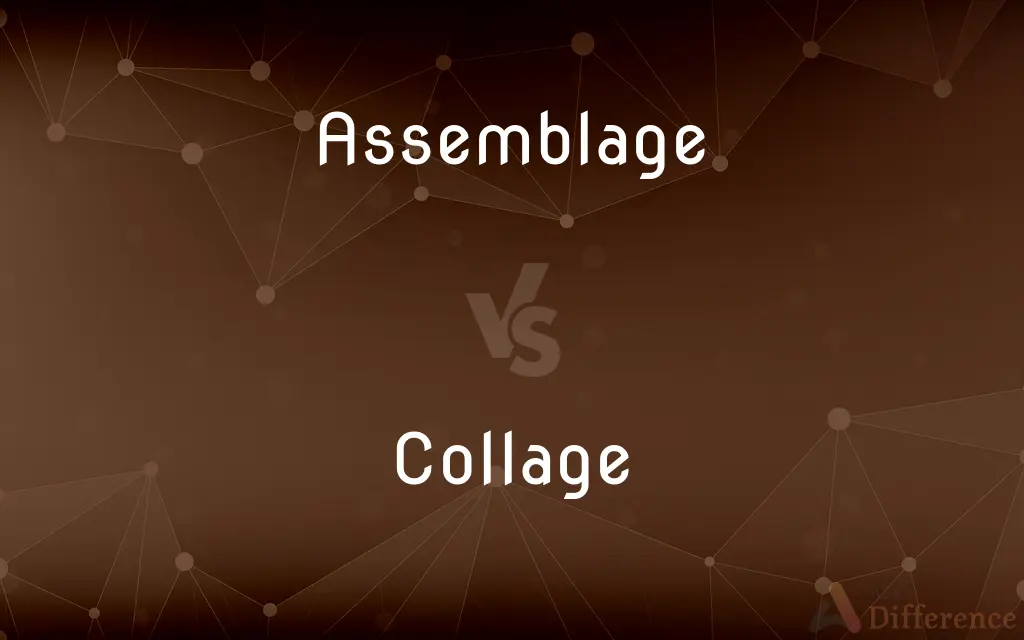Assemblage vs. Collage — What's the Difference?
Edited by Tayyaba Rehman — By Maham Liaqat — Updated on April 27, 2024
Assemblage involves creating three-dimensional artistic compositions from found objects, while collage involves combining two-dimensional materials, like paper and fabric, on a flat surface.

Difference Between Assemblage and Collage
Table of Contents
ADVERTISEMENT
Key Differences
Assemblage is a form of sculpture comprising found objects arranged in a three-dimensional space to create a unified whole, whereas collage involves pasting various materials such as paper, photographs, and fabric onto a surface, forming a two-dimensional artwork.
The technique of assemblage allows artists to explore the textural and spatial relationships between unconventional materials, on the other hand, collage focuses on the visual and thematic juxtapositions of flat images and textures.
Artists use assemblage to challenge traditional notions of sculpture by incorporating everyday items, thus adding a layer of conceptual depth, while collage artists often manipulate paper and other materials to comment on the interplay of different visual elements or societal themes.
Assemblage can include components that are both fixed and movable, allowing for dynamic interactions within the artwork, whereas collage typically results in a static, flat piece meant for visual examination from a single perspective.
While assemblage may require a physical space and can be experienced from multiple angles and contexts, collage is usually more accessible and can be displayed and viewed in traditional settings like galleries without spatial constraints.
ADVERTISEMENT
Comparison Chart
Dimensions
Three-dimensional
Two-dimensional
Materials
Found objects, including metal, wood
Paper, photographs, fabric, and others
Artistic Focus
Spatial and textural relationships
Visual and thematic juxtapositions
Interaction
Can be interactive and dynamic
Static and visual
Display Requirements
Requires physical space for display
Easily displayed on flat surfaces
Compare with Definitions
Assemblage
Assemblage artists often repurpose items to challenge viewers' perceptions of art and objects.
She collected discarded furniture to create assemblages that comment on consumer culture.
Collage
Collage allows for the exploration of complex themes through the layering and combination of images.
Her collages explore themes of identity and memory with layers of photographic images.
Assemblage
Assemblage art can vary widely in size and complexity, depending on the objects and space used.
The large-scale assemblage filled the gallery, offering myriad details to explore.
Collage
Collage is particularly popular in mixed media art, where it combines with painting, drawing, and other artistic expressions.
His artwork combines collage with bold acrylic painting, blending textures and colors.
Assemblage
An artistic form that involves combining found objects into a three-dimensional sculpture.
The artist's assemblage used old toys and metal scraps to create a striking figure.
Collage
A technique in visual arts where the artwork is made from an assemblage of different forms, thus creating a new whole.
He used vintage photos and magazine clippings to create his collage.
Assemblage
Focuses on constructing new meanings and narratives through the physical arrangement of materials.
His assemblage art often evokes personal memories through the use of everyday items.
Collage
Artists may use collage as a means to quickly sketch ideas or concepts in a visual form.
The designer used collage techniques to prototype her ideas for the book cover.
Assemblage
The process of assemblage can be seen as a physical dialogue between artist and materials.
Each piece in her assemblage interacts with the others, creating a complex visual and textural conversation.
Collage
Often used to create abstract or representational art by arranging disparate visual elements into a cohesive composition.
The collage juxtaposed sharp, angular forms with soft, flowing images to express conflict.
Assemblage
The act of assembling.
Collage
Collage (, from the French: coller, "to glue" or "to stick together";) is a technique of art creation, primarily used in the visual arts, but in music too, by which art results from an assemblage of different forms, thus creating a new whole. (Compare with pastiche, which is a "pasting" together.) A collage may sometimes include magazine and newspaper clippings, ribbons, paint, bits of colored or handmade papers, portions of other artwork or texts, photographs and other found objects, glued to a piece of paper or canvas.
Assemblage
The state of being assembled.
Collage
A piece of art made by sticking various different materials such as photographs and pieces of paper or fabric on to a backing.
Assemblage
A collection of people or things; a gathering.
Collage
An artistic composition of materials and objects pasted over a surface, often with unifying lines and color.
Assemblage
A collection of items from a single datable component of an archaeological site.
Collage
A work, such as a literary piece, composed of both borrowed and original material.
Assemblage
A fitting together of parts, as those in a machine.
Collage
The art of creating such compositions.
Assemblage
A sculptural composition consisting of an arrangement of miscellaneous objects or found materials.
Collage
An assemblage of diverse elements
A collage of conflicting memories.
Assemblage
The process of assembling or bringing together.
The assemblage of words and recordings
Collage
To paste (diverse materials) over a surface, thereby creating an artistic product.
Assemblage
A collection of things which have been gathered together or assembled.
Collage
To create such an artistic product.
Assemblage
(archaeology) A group of different artifacts found in association with one another.
Collage
A picture made by sticking other pictures onto a surface.
Assemblage
(arts) A visual art form similar to collage, which combines two-dimensional and three-dimensional, often found, elements into works of art.
Collage
A composite object or collection (abstract or concrete) created by the assemblage of various media; especially for a work of art such as text, film, etc.
Richard Brautigan's novel So the Wind Won't Blow It All Away is a collage of memories.
Assemblage
The act of assembling, or the state of being assembled; association.
In sweet assemblage every blooming grace.
Collage
(uncountable) The technique of producing a work of art of this kind.
Assemblage
A collection of individuals, or of individuals, or of particular things; as, a political assemblage; an assemblage of ideas.
Collage
(transitive) To make into a collage.
Collage the picture together.
Assemblage
A group of persons together in one place
Collage
Any picture made by sticking together pieces of paper or photographs, especially in unusual or surprising ways.
Assemblage
A system of components assembled together for a particular purpose
Collage
The technique of producing a work of art that is a collage{1}.
Assemblage
The social act of assembling;
They demanded the right of assembly
Collage
Any composite object, whether abstract or concrete, created by assembling components of varied types.
Assemblage
Several things grouped together or considered as a whole
Collage
A film having scenes of different types or from different locations displayed in rapid succession without transitions.
Collage
A paste-up made by sticking together pieces of paper or photographs to form an artistic image;
He used his computer to make a collage of pictures superimposed on a map
Collage
Any collection of diverse things;
A collage of memories
Common Curiosities
How do artists choose materials for collage?
Artists choose materials based on texture, color, and the visual or thematic relationships they can create.
How has digital technology impacted collage art?
Digital technology allows artists to create digital collages using software, expanding the technique’s possibilities.
How can beginners start creating collages?
Beginners can start with simple materials like magazines, scissors, and glue to experiment with basic collage techniques.
What is the main visual difference between assemblage and collage?
Assemblage is three-dimensional and can be viewed from multiple angles, while collage is flat and viewed from one perspective.
How do assemblage artists find their materials?
Assemblage artists often collect materials from everyday sources, like junkyards, thrift stores, or natural settings.
What materials are commonly used in assemblage art?
Assemblage art often uses materials like wood, metal, and found objects.
Can collage include three-dimensional elements?
While typically two-dimensional, some collages incorporate small three-dimensional elements to add depth.
What are some historical examples of collage?
Historical examples include works by Pablo Picasso and Georges Braque, who pioneered the use of collage in modern art.
Is assemblage art considered a form of recycling?
Yes, assemblage often involves repurposing discarded items, which can be seen as a form of recycling.
Can assemblage be used in commercial art?
Yes, assemblage can be used in commercial art, especially in window displays and conceptual installations.
How do museums display assemblages?
Museums may require special mounts or stands to properly display assemblages, considering their often complex and fragile nature.
What skills are important for creating assemblages?
Important skills include a good sense of spatial relationships, material handling, and a creative vision for reinterpreting objects.
Are there any famous artists known for both techniques?
Artists like Robert Rauschenberg are known for using both assemblage and collage, often blending the two in innovative ways.
What are the key conceptual differences between assemblage and collage?
The key differences lie in the dimensionality and the types of materials used, reflecting different artistic intentions and effects.
What are some challenges faced by artists working with collage?
Challenges include finding the right adhesive, preserving the materials, and achieving the desired visual balance.
Share Your Discovery

Previous Comparison
Circle vs. Ring
Next Comparison
Annoyed vs. FrustratedAuthor Spotlight
Written by
Maham LiaqatEdited by
Tayyaba RehmanTayyaba Rehman is a distinguished writer, currently serving as a primary contributor to askdifference.com. As a researcher in semantics and etymology, Tayyaba's passion for the complexity of languages and their distinctions has found a perfect home on the platform. Tayyaba delves into the intricacies of language, distinguishing between commonly confused words and phrases, thereby providing clarity for readers worldwide.
















































